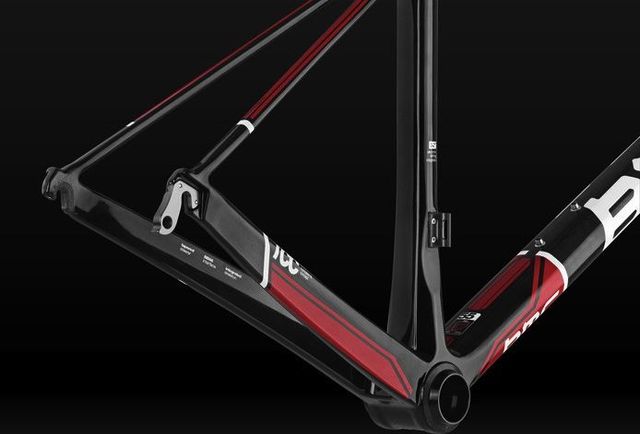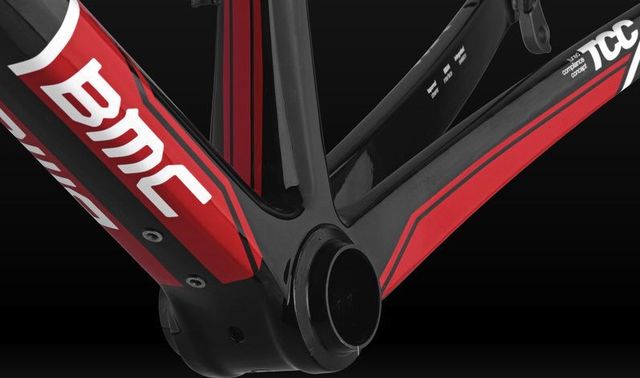
Since Cadel Evans won the 2011 Tour de France, has unveiled a pair of pro-level bikes, including the classics-oriented GrandFondo GF01 and a yet-to-be-publicized . And while those bikes—in addition to the TT-oriented TimeMachine TM01—may factor in his title defense this Saturday, the Aussie will rely primarily on the same bike he won with last year, the TeamMachine SLR01. You might wonder why one of the best racers in the world doesn’t have a new bike model for the most important race of the season. Having spent the last half-year testing the SLR01, we have the answer: This bike is just that good.
THE FRAME
The SLR01 is not BMC’s most expensive road frame. That honor goes to , a bicycle that took over five years and $40 million (in the form of a dedicated new factory) for the company to create. So why would Evans choose the SLR01 over this super bike? “Cadel prefers the compliance of the SLR01,” Markus Eggiman, BMC’s marketing manager told me. Put another way, the SLR01 is more comfortable than the Impec, and comfort is at the heart of the story of this bike.
The SLR01’s ride quality comes from what BMC calls its Tuned Compliance Concept. The idea is this: While most of the frame is laid up with unidirectional fibers to make the bike as stiff and responsive as possible, key areas (including the seat stays, fork, and seat post) have multi-directional fibers that allow a higher degree of vertical flex, hence comfort. The changes are visible in the form of trimmer profiles and different patterning, but it still sounded like a mean marketing pitch to us. After months on the SLR01, however, we have to admit that it really works.
This bike is as snappy and quick as any we’ve ridden, but it doesn’t have the hard edge of most race bikes. We rode very long days on it (up to seven hours) and never felt beat up the way we do on stiffer race bikes. The frame silenced the chatter of even the most pitted and beat-up New Mexico pavement better than comparable endurance-oriented bikes such as the Specialized Roubaix.

But this is no sluggish comfort-performance ride. The combination of the massive bottom bracket area and the huge rectangular chain stays created instantaneous acceleration, and the oversize tapered head tube and longish-but-comfortable geometry made for nimble but balanced handling. The tolerances on the new BB86 bottom bracket are so precise that the sleeved bearing cartridges press straight into the bottom bracket sheel, and while we can't say we noticed it being significantly stiffer than other standards, it was rock solid with zero flex. Steering is swift—but in a calm way, not twitchy. And at 14.8 pounds, the bike definitely surges hard when you get out of the saddle.
The SLR01 is perhaps not the quickest descender we’ve ever ridden, but we quickly grew to like its stolid feel on the sinuous, technical descent down nearby Ski Santa Fe. We pushed hard lines into tight switchbacks and always felt confident, even when we were going a touch faster than we should have. It’s so steady that we occasionally started thinking of the SLR01 as a distance cruiser—until we were hammering off the front of group rides on it and dropping fast racers up steep pitches.
THE PARTS
As you’d expect for a bike in this price range, there are no letdowns on the parts front. Short of electric, Shimano Dura Ace mechanical is, to us, the best performance you can buy. Shifting is immediate, especially in the rear, and we tuned it only once (on initial setup) and never had to think about it again for six months of hard riding. Braking is extremely predictable if a little underpowered, a niggle that Shimano says will be more than rectified with a powerful new design in the latest iteration of Dura Ace. In short, if you aren’t ready to throw down for Di2 but are still willing to spend some money, the refinement and quiet of Dura Ace is your best bet.

Other smart picks include the Easton EC90 bars, with carbon that really helped in damping the ride and a slightly squared bend that felt natural in the drops. The Fi’zik Arione saddle is both fairly light and extremely benign and comfortable. One asterisk: Whereas our test bike came with Easton EA90 wheels, this level SLR01 normally ships with the carbon EC90s, which would make the bike lighter and quicker still. Easton wheels aren’t maybe as sexy as some of the other wheelsets on the market, but we’ve found them to be simple, smooth rolling, and extremely reliable, and several of our testers have happily spec’d them on their personal bikes.
THE BOTTOM LINE
As should probably be expected of the bike that Cadel will race in the Tour, the SLR01 is fast and feathery and responsive. It’s neither miraculously light like the Cannondale Supersix EVO nor freaky stiff like the Look 695, but it finds an elegant middle ground between the two. And what’s most surprising is that it manages to pack as much comfort as it does performance. It’s a race bike disguised as an all-arounder—you can ride this fast anytime, in every condition, and all day long. And we’re partial to BMC’s distinctive yet understated styling. At $9,000, the price is steep, and the $7,000 Ultegra Di2 model is cheaper but no bargain. The payback, though, is getting not just a jack of every trade, but the master of all of them. Just ask Cadel.
—Aaron Gulley